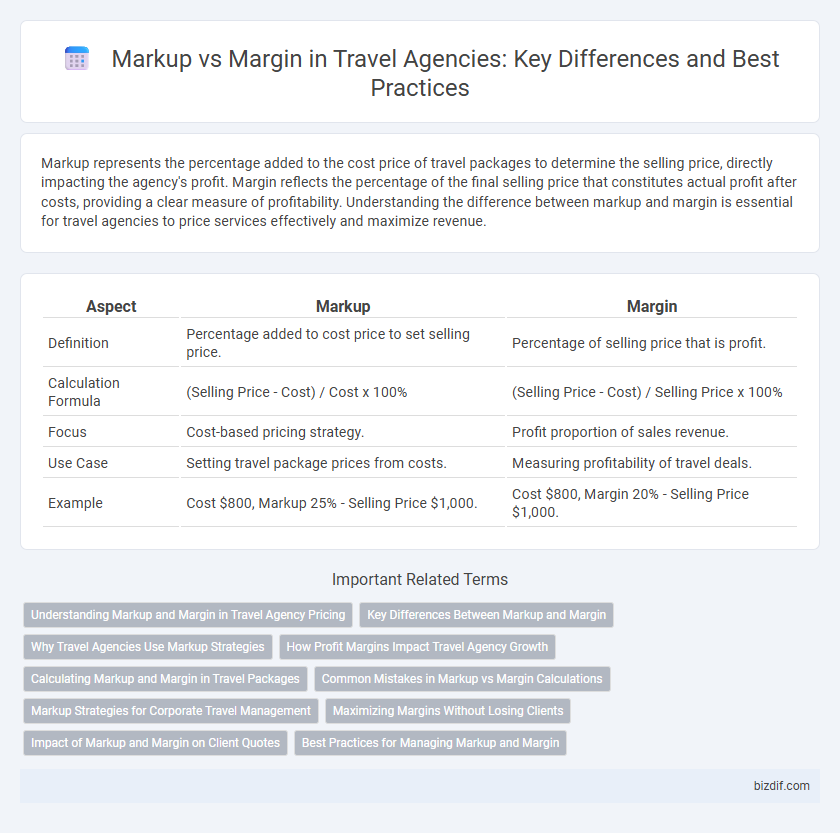Markup represents the percentage added to the cost price of travel packages to determine the selling price, directly impacting the agency's profit. Margin reflects the percentage of the final selling price that constitutes actual profit after costs, providing a clear measure of profitability. Understanding the difference between markup and margin is essential for travel agencies to price services effectively and maximize revenue.
Table of Comparison
| Aspect | Markup | Margin |
|---|---|---|
| Definition | Percentage added to cost price to set selling price. | Percentage of selling price that is profit. |
| Calculation Formula | (Selling Price - Cost) / Cost x 100% | (Selling Price - Cost) / Selling Price x 100% |
| Focus | Cost-based pricing strategy. | Profit proportion of sales revenue. |
| Use Case | Setting travel package prices from costs. | Measuring profitability of travel deals. |
| Example | Cost $800, Markup 25% - Selling Price $1,000. | Cost $800, Margin 20% - Selling Price $1,000. |
Understanding Markup and Margin in Travel Agency Pricing
Markup represents the percentage added to the travel agent's cost price to determine the selling price, directly impacting profitability on tours and packages. Margin indicates the percentage of the final selling price that constitutes profit, revealing the actual earnings from travel services sold. Accurate understanding of markup and margin helps travel agencies set competitive prices while maintaining healthy profit levels on flights, accommodations, and tour bookings.
Key Differences Between Markup and Margin
Markup represents the percentage added to the cost price of a travel package to determine its selling price, while margin refers to the percentage of the selling price that constitutes profit. Markup is calculated based on cost, typically higher than margin for the same profit level, whereas margin is based on the final sale price, offering a clearer view of profitability. Understanding these key differences helps travel agencies set competitive prices and accurately assess profit performance.
Why Travel Agencies Use Markup Strategies
Travel agencies use markup strategies to cover operational costs and ensure profitability while offering competitive prices on travel packages. Markup allows agencies to transparently add a percentage over the wholesale cost of flights, hotels, and tours, helping them manage varying supplier rates and fluctuating market demand. This approach enhances pricing flexibility, enabling travel agencies to tailor offers that optimize revenue without compromising customer value.
How Profit Margins Impact Travel Agency Growth
Profit margins directly influence a travel agency's ability to reinvest in marketing, technology, and staff training, driving sustainable business growth. Understanding the difference between markup and margin helps agencies price tours competitively while ensuring sufficient profitability to expand services. Optimized profit margins enable travel agencies to enhance customer experiences and scale operations effectively in a competitive travel market.
Calculating Markup and Margin in Travel Packages
Calculating markup and margin in travel packages involves understanding the relationship between cost price and selling price. Markup is determined by dividing the difference between the selling price and cost price by the cost price, expressed as a percentage, which helps set profitable rates on flights, accommodations, and tours. Margin is calculated by dividing the difference by the selling price, providing clear insight into the profitability percentage of travel packages offered by the agency.
Common Mistakes in Markup vs Margin Calculations
Common mistakes in markup vs margin calculations often arise from confusing the two financial metrics, leading to inaccurate pricing strategies in travel agency packages. Markup is calculated based on cost, whereas margin is based on sales price, and mixing these formulas can result in underestimating costs or overpricing tours. Ensuring precise differentiation between markup and margin improves profitability analysis and prevents revenue loss in travel service offerings.
Markup Strategies for Corporate Travel Management
Effective markup strategies in corporate travel management revolve around setting a percentage increase on direct costs to ensure profitability while maintaining competitive pricing. Travel agencies often apply tiered markup models tailored to client size and travel complexity, optimizing revenue without compromising value. Incorporating dynamic markup adjustments based on seasonality and booking lead time enhances financial control and client satisfaction.
Maximizing Margins Without Losing Clients
Maximizing margins in a travel agency requires understanding the distinction between markup and margin, where markup is the percentage added to the cost price and margin represents the profit percentage on the selling price. Strategic pricing should focus on competitive markup levels that maintain client loyalty while ensuring healthy profit margins. Utilizing dynamic pricing tools and personalized offers allows travel agencies to optimize margins without compromising customer retention or satisfaction.
Impact of Markup and Margin on Client Quotes
Markup directly influences the final client quote by increasing the base cost to establish the travel agency's selling price, which can affect perceived value and competitiveness. Margin impacts profitability by determining the percentage of revenue retained after costs, guiding pricing strategies to ensure sustainable business operations. Both markup and margin adjustments play a crucial role in balancing attractive client quotes with maintaining healthy profit levels.
Best Practices for Managing Markup and Margin
Effective management of travel agency markup and margin involves accurately calculating costs and setting competitive prices that maximize profitability. Implement dynamic pricing strategies based on market demand, seasonal trends, and customer preferences to optimize revenue while maintaining customer satisfaction. Utilize integrated software tools to track costs, sales, and profit margins in real time, ensuring data-driven decisions and agile adjustments in pricing tactics.
Markup vs Margin Infographic

 bizdif.com
bizdif.com